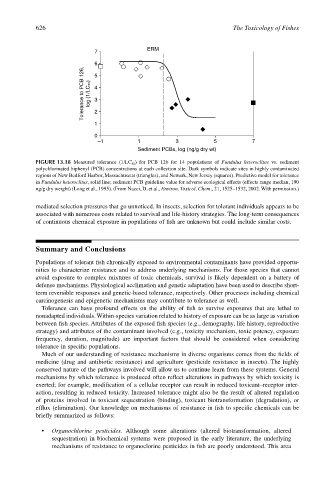Page 646 - The Toxicology of Fishes
P. 646
626 The Toxicology of Fishes
ERM
7
6
Tolerance to PCB 126, log (1/LC50) 4
5
3
2
1
0
–1 1 3 5 7
Sediment PCBs, log (ng/g dry wt)
FIGURE 13.18 Measured tolerance (1/LC 50 ) for PCB 126 for 14 populations of Fundulus heteroclitus vs. sediment
polychlorinated biphenyl (PCB) concentrations at each collection site. Dark symbols indicate sites in highly contaminated
regions of New Bedford Harbor, Massachusetts (triangles), and Newark, New Jersey (squares). Predictive model for tolerance
in Fundulus heteroclitus, solid line; sediment PCB guideline value for adverse ecological effects (effects range median, 190
ng/g dry weight) (Long et al., 1995). (From Nacci, D. et al., Environ. Toxicol. Chem., 21, 1525–1532, 2002. With permission.)
mediated selection pressures that go unnoticed. In insects, selection for tolerant individuals appears to be
associated with numerous costs related to survival and life-history strategies. The long-term consequences
of continuous chemical exposure in populations of fish are unknown but could include similar costs.
Summary and Conclusions
Populations of tolerant fish chronically exposed to environmental contaminants have provided opportu-
nities to characterize resistance and to address underlying mechanisms. For those species that cannot
avoid exposure to complex mixtures of toxic chemicals, survival is likely dependent on a battery of
defense mechanisms. Physiological acclimation and genetic adaptation have been used to describe short-
term reversible responses and genetic-based tolerance, respectively. Other processes including chemical
carcinogenesis and epigenetic mechanisms may contribute to tolerance as well.
Tolerance can have profound effects on the ability of fish to survive exposures that are lethal to
nonadapted individuals. Within-species variation related to history of exposure can be as large as variation
between fish species. Attributes of the exposed fish species (e.g., demography, life history, reproductive
strategy) and attributes of the contaminant involved (e.g., toxicity mechanism, toxic potency, exposure
frequency, duration, magnitude) are important factors that should be considered when considering
tolerance in specific populations.
Much of our understanding of resistance mechanisms in diverse organisms comes from the fields of
medicine (drug and antibiotic resistance) and agriculture (pesticide resistance in insects). The highly
conserved nature of the pathways involved will allow us to continue learn from these systems. General
mechanisms by which tolerance is produced often reflect alterations in pathways by which toxicity is
exerted; for example, modification of a cellular receptor can result in reduced toxicant–receptor inter-
action, resulting in reduced toxicity. Increased tolerance might also be the result of altered regulation
of proteins involved in toxicant sequestration (binding), toxicant biotransformation (degradation), or
efflux (elimination). Our knowledge on mechanisms of resistance in fish to specific chemicals can be
briefly summarized as follows:
• Organochlorine pesticides. Although some alterations (altered biotransformation, altered
sequestration) in biochemical systems were proposed in the early literature, the underlying
mechanisms of resistance to organoclorine pesticides in fish are poorly understood. This area

